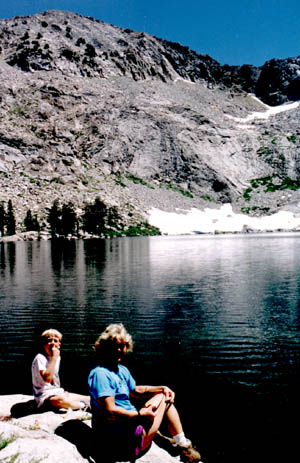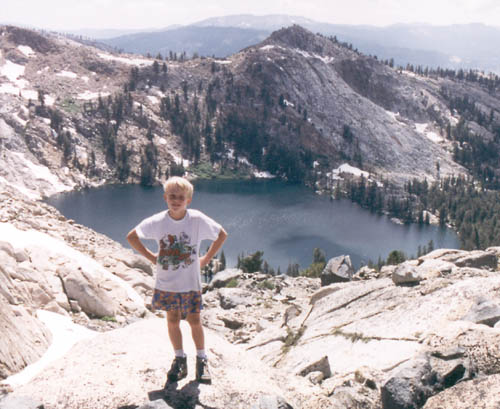
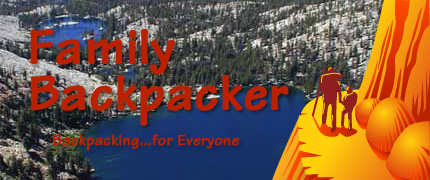
Some time ago Toby, Susan and I were eating in a restaurant. I ordered a beer along with dinner. When it arrived Toby asked, "Dad, are you going to drink that big old beer and then drive?" I replied that I was going to dilute it with a bunch of food, and that it would be a while before we left the restaurant, so it should be fine. The thing is, I really wanted a second beer, but paying attention to his question made me think, and made me refrain.
I think it is important for us adults to not only show the way to our children, but to demonstrate it by modeling the way we want them to behave.
We want to raise our children with a love of the outdoors because we like the values it imparts, or because it is a wholesome activity for them, or maybe something else. I like it because it gives us parents a healthy and natural forum from which to pass on the "wisdom of the elders" to the children. I look forward to backpacking as an opportunity to extend this dymanic, and strengthen the three-way bond between the parents, the children and the outdoors.
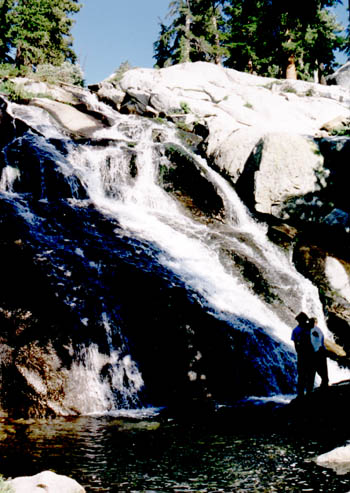
Following is the framework of a plan a group of families used in 2000 to have a successful and rewarding backpack trip. It was designed so that individual families could plan their own part, but still come together as a group.
As a basic plan, it can be adapted for use by individuals, families, or groups of families, and different locations. Use it as a framework for planning your own outdoor adventure with your family.
Everything here is tentative and flexible. If you don’t like something or have another idea or something to add, please let me know.
Middle Chain Lake is one of a set of three pristine alpine lakes located one above the other between the arms of two 10,500-foot peaks that forma part of the southern boder of Yosemite National Park. 2. Remoteness. Located at the extreme southern edge of Yosemite National Park and accessed from a remote trailhead, it doesn't see as much use as most other Yosemite lakes. When visited during mid-week lets us experience a genuine alpine wilderness gem. Yet it’s only a 5.5 mile hike, which is great for kids (and older adults). Mostly uphill, from 8,000 feet at the trailhead to 9,000 feet at Middle Chain Lake. Fishing, swimming, stargazing, climbing, hiking. August. Earlier means colder water for swimming and more mosquitos. Later pushes up against cooler weather and start of school.
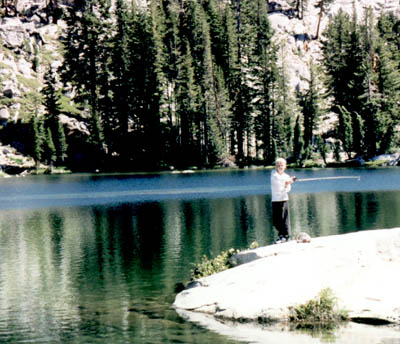
For visitors entering the Yosemite National Park via Chiquito Pass in the Sierra National Forest, permits for the whole trip must be obtained from the Sierra National Forest Office/Oakhurst Visitor Center in Oakhurst. Call (569) 658-7588 for more information.
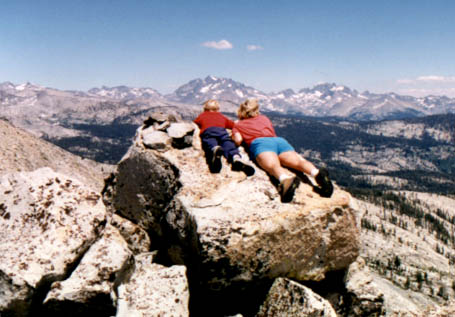
You can obtain a group wilderness permit good for up to 15 people.
I believe in trying to make things as easy and comfortable as possible, especially with kids. Afte you've chosen a destination and trailhead, locate the nearest town and make reservations to stay at a motel the night before the hike in.
Our trip was composed of 5 families and a total of 18 people. We all live in Sonoma County, north of San Francisco, and our destination was Chain Lakes, on the southern border of Yosemite National Park. The nearest town to the trailhead is Oakhurst, a fice-hour drive, and it's about an hour drive from there to the trailhead.
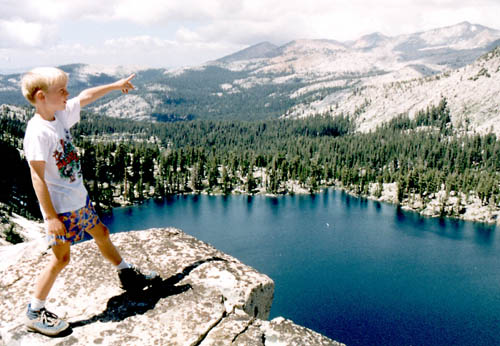
Day One - Saturday:
We all drive to Oakhurst. I pick up group wilderness permit at the ranger staion in town. Spend the night at Sierra Sky Ranch, where we have reservations. Prepare packs and equipment. Sierra Sky Ranch is a pleasant, rustic old motel on Highway 41 outside of Oakhurst, with swimming pool and restaurant. No TV. Full restaurant there, or eat in town ten minutes away.
Morning: Breakfast. Drive to Chiquito Pass trailhead. Hike 5.5 miles to Middle Chain Lake. Lunch on the trail. Set up main camp and individual camp sites. Kids carry out assigned duties - firewood gathering, site preparation, pumping water, etc.
Day Three - Monday:
Breakfast, camp clean-up.
Activity: fishing, hike to Upper Lake, swimming.
Possibilities:
Nature sounds
Find your tree
Rope making
Knot tying
Star gazing
Cleaning a fish
Sing a song
Recite a poem
Read a Story
Share a talent
Dinner, clean-up, camp fire, discussion of tomorrow’s activities.
Day Four - Tuesday:
Breakfast, camp clean-up.
Activity: Long hike to Breeze Lake, fishing, swimming.
Parent-led activity.
Dinner, camp fire, discussion of tomorrow’s activities.
Breakfast, camp clean-up.
Activity: Peak climb.
Parent-led activity.
Camp clean-up and organizing for breaking camp
Dinner, camp fire, discussion of tomorrow’s activities.
Closing ceremony.
Breakfast. Break camp; clean-up; site inspection. Hike out.
Afternoon: Drive to Sky Ranch for dinner, shower, swimming, spend the night.
Day Seven - Friday:
Drive home.
It’s a short hike to Upper Chain Lake (elevation 9,200 feet) for fishing and (brisk) swimming. The lake basin is held between two arms of Gale Peak (10,693 feet) and Sing Peak (10,552 feet), where snow still clings to the higher rocks even in late summer. The area between Middle and Upper lakes is full of wildflowers and meandering streams. Don't miss the waterfall at the inlet of Middle Lake - it's a wonderful place for a dip.
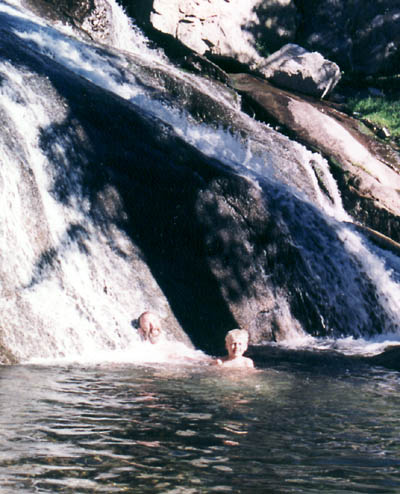
Kids should prepare their own packs as much as possible. The following check list is for suggestion only; many of the items are not necessities, and everyone is encouraged to pack any useful or fun items they may think of. As in any pack trip, weight is all-important. Remove food items from their packaging, seal it in Zip-Loc bags, and leave the packaging behind. Shop for the smallest, lightest items you can find. Share. Some items (like tent and water filter) can be shared between two or more people.
Remember the backpackers' mantra: When in doubt, leave it out. However, also remember that we are not doing a 50-mile hike. We just need to get our stuff six miles up a hill to base camp. But you should try to plan it so that on hike-out day, the only food you're carrying is stuff you're going to eat on the trail, and the only clothes you're carrying are filthy.
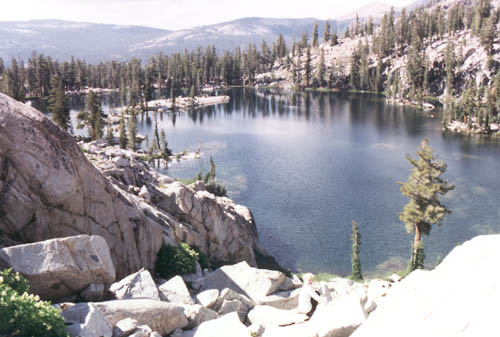
Backpacking and camping supplies can be obtained locally at Sonoma Outfitters (great selection, top quality, can be expensive), REI (the premier outdoors store, well worth a membership). The local Sportmart, Big 5, Walmart and Target all have inexpensive supplies, too.
You can shop online as well. REI.com has a terrific web site. But you probably won’t find many more bargains than you will at Campmor.com.
Remember, your backpack is your house on your back, and like a house, it has many rooms.
The weather at Chain Lakes in August will probably be consistently sunny days with cool nights. But this is the mountains, at altitude, and there's always a chance of rain, or even snow - but not likely. Clothing should basically lean towards shorts and t-shirts during the day, sweat shirts and sweat pants in the evening, and a light jacket for the early morning. If it rains, you can either pack a poncho, or use a space blanket (which doubles as a ground cloth).
Hiking in: Wear shorts, t-shirt, underwear, socks, boots, hat. Have access to a hanky.
In a single stuff sack:
3 t-shirts
4 pair underwear
4 pair socks
2 pair shorts
swim suit
small towel
sweat pants
sweat shirt
long-sleave flannel shirt
windbreaker or light jacket
nightwear: polypro top and bottom
extra stuff sack for dirty clothes
I think it is more important for kids to learn to plan food as they would for a pack trip for one or two people, rather than planning a part of what’s needed for a large group. Thus, I’ll lay out what food I plan to bring for Toby, Susan and myself, for four dinners, breakfasts and lunches. It might be helpful for you to use this information to plan your own family’s food for the trip.
Lot's of packers like the dried, prepared packets available in outdoors stores. I find off-the-shelf packaged dinners from the loacal groacery store work just as well. Transfer the contents of the box (recycling the box) to zip-lock bags, along with the cut-out cooking instructions.
Sunday:
Dinner: Noodles parmesan (from package) with broccoli; salad (cucumber, carrot, celery, zucchini with dressing) Dessert: SmoresMonday:
Breakfast: Cream of wheat (instant), granola, milk (instant); fruit (apple); coffee.
Lunch: Instant soup, cheese, fig bars, fruit.
Dinner: Basmati rice with shrimp (canned) and butter (squeeze); broccoli. Dessert: pudding.Tuesday:
Breakfast: Cream of wheat (instant), granola, milk (instant); fruit (apple); coffee.
Lunch: Instant soup, cheese, fig bars, fruit.
Dinner: Campfire foil packs - potato, onion, carrots, butter... and trout! Dessert: Smores.Wednesday:
Breakfast: Cream of wheat (instant), granola, milk (instant); fruit (apple); coffee.
Lunch: Instant soup, cheese, fig bars, fruit.
Dinner: Noodle casserole with tuna; salad. Dessert: pudding.Thursday:
Breakfast: Cream of wheat (instant), granola, milk (instant); fruit (apple); coffee.
The food list for the above menu would look like this:
2 packages noodle dinners, put (with cut-out instructions) into zip bags
1 cup basmati rice
2 potatoes
1 head of broccoli (stems removed)
1 cucumber
2 carrots
1 onion
2 stems celery
1 zucchini
small plastic container salad dressing
1 can baby shrimp
1 can tuna
small container margarine
whole wheat fig bars
3 apples
3 oranges
mozzarella cheese
6 packages instant soup
8 packs instant cream of wheat
granola
6 individual containers pudding
aluminum foil
coffee filters
4 shrink-wrapped coffee packs
instant hot chocolate packs
instant milk
marshmallows
chocalate bars
graham crackers
trail mix
a few surprisesAlso:
matches
fuel
stove
cook pans
knife/fork/spoon
bowl
cup
bio soap
scrubber
trash bag
water filter
water bottle
paper towels
As much as practical, I'll try to fit all of this into two stuff bags.
toothbrush
tooth paste
comb
toilet paper
shovel
tent
ground cloth
rain fly
sleeping bag
pillow
pad
flashlight
book
musical instrument
cards/games
sunscreen
insect repellent
hat
sunglasses
map
star chart
handkerchief
first aid kit
fishing rod
fishing reel
lures/tackle
folding knife
whistle
camera
film
ditty bag
binoculars
string/rope
nature guides
extra stuff sack
No electronic games
No radios
No CD players
No pets
No alcoholic beverages
A large group is a major endeavor, especially with a relatively young group. It is essential that you develop a set of rules and that you all agree to abide by them. Here’s what the rangers in the park say about group camping in the wilderness:
"Large groups provide an excellent opportunity to actively teach, review, and practice minimum impact techniques. Instill in group members a respect and a sense of stewardship for the land. It is especially important to cover the many aspects of proper wilderness use with every group member, and to practice minimum impact camping at all times while in the wilderness."
WILDERNESS RULES
Chain Lakes is a sensitve, high-altitude alpine wilderness, and must be treated with respect. We want to minimize our impact on the area.
Noise: Try to be as quiet as possible. You need to have fun, and you’ll have lots of yells (wait til you hear the echoes!), but no unnecessary screaming or other loud noises. Remember, people go to this area for solitude, and it would be unfortunate if you ruined someone else’s summer vacation.
Fires: Using an existing fire ring, try to have a single campfire of moderate size, lit only in the evening. Use only downed, dead wood. Woodgatherers will have to scavenge over a large area. General campfire rules apply (no horseplay around the fire, no burning plastic or trash, etc.). No cutting or damaging of live wood.
Trail: Stay on the trail; no cutting switchbacks. Wait at trail junctions for the rest of the group. The quieter you are, the more wildlife you’ll see. Uphill hikers and livestock have the right of way. Move to the uphill side of the trail and wait for them to pass.
Camp: Dump cooking water, waste and dishwater at least 100 feet from creek or lake. Use only biodegradable soap. Burn small paper waste, but compact plastic and metal trash and place it in the camp trash bags - we will pack it out. Needless to say, do not litter. This includes orange peels, apple cores and the like. Establish a group washing area at least 100 feet away from any water source and restore the area to a natural looking state when you are ready to leave. You should have large containers to carry water away from stream or lake shores for use.
Food Storage: I have yet to see any sign of bears at Chain Lakes - but don't sepend on that knowledge. Bears have wide ranges, are everywhere in the wilderness, and can be aggressive.
Always store garbage, cosmetics, toothpaste, soap, or anything with any odor with food. Store items properly at all times except when preparing what is needed for your meal. Leave empty packs on the ground with all pockets and flaps open. Store water bottles out of sight with cooking gear.
Canisters. Bear resistant food storage canisters are currently the only effective portable means of food storage in Yosemite’s wilderness. These portable containers are the most effective way for backpackers to store food in wilderness. Each plastic canister weighs less than 3 pounds, fits in a full-sized backpack, and is capable of holding up to 3 to 5 days worth of food for one person. Canisters are available for rent for $3.00 a trip at most permit stations and many stores within Yosemite. Canisters can be returned at any rental location.
The Counter Balance Method. Although the counter-balance method of food storage is not illegal, it is not recommended due to its lack of effectiveness and the damage that is caused to trees by persistant bears. If you choose to store your food using this technique, consider it only a delaying tactic. Be prepared to actively defend your food and repeatedly scare bears out of your camp through the night. Without this negative reinforcement, bears will figure out a way to get your counter-balanced food - some bears will go so far as to literally chew the branch off the tree to get at food bags.
Bear-bagging can be pretty entertaining.
Water: Giardiasis is an intestinal disease caused by Giardia lamblia, a water-borne protozoan. Giardia is carried by humans and some domestic and wild animals that may contaminate lakes and streams. All water or melted snow must be treated by boiling for at least 5 minutes, using an iodine-based purifier, or using a Giardia-rated water filter. Associated symptoms include chronic diarrhea, abdominal cramps, bloating, fatigue, and loss of weight. Treatment by a physician is necessary to kill the organisms.
Drinking any untreated water in the wilderness will make you sick. You can treat water three ways:
1) Filtration: the preferred method, all kids should feel free to pump water through a filter any time they want to;
2) Boiling 3-5 minutes;
3) Use an iodine based chemical purifier.
Human waste: Number One - Pee off the trail, at least 100 feet from any water source.
Number Two - Find a secluded place 100 feet or more from any water source and from camp. Dig a small hole 6 to 8 inches deep, and position yourself over it. Ready, aim, fire. Use a small amount of TP. Carry a Zip-Loc bag and put used toilet paper in it; pack it out. Fill in the hole and return it to as natural a state as possible. Do not just plant a rock on it and leave.
Also...
Do not put anything in the lake or streams; even "biodegradable" soap pollutes.
Do not build rock walls, bough beds, new fire rings, trenches, or campsite "improvements."
Do not pick wildflowers. This is a misdemeanor in California.
Do not feed the animals.
RULES FOR OUR GROUP
Upon arrival - Select tent sites in established areas 100 feet or more from the lake or stream. Look for a level site big enough to handle your tent. Disturb the area as little as possible. Do not pound nails in (live) trees or otherwise damage vegetation. Put rain flies on tent.
Daily - Assign real daily schedules, with rotating duties, including lots of free time. An hour after breakfast will be devoted daily to camp clean-up. This means washing, drying and putting away all cooking utensils, making bed areas neat and generally making the camp clean and tidy.
Evening - All food must be (by federal law) put up in a way to protect it from bears. Last person up makes sure the fire is OUT before going to bed.
Breaking camp - The evening before the final night, organize everything for the hike out.
After breakfast on the last morning, carefully pack up everything. Leave the camp site in a condition that is cleaner than we found it. Before you put your pack on your back, look around thoroughly for every human-made item.
BREAKING THE RULES
Most of our rules are simple and common sense. Everyone, kids and parents, will be asked to agree to the rules. If anyone can’t do this, then we will try to compromise on the rules so that everyone can feel comfortable with them.
Once you agree, though, you have to obey the rules. Rule breakers will be given a warning for a first offense. Subsequent offenses will result in grounding for the next activity. You want to have fun, but it should not be forgotten that you are in the wolderness, and you can get into trouble easily if you are not paying attention. And it's a long ways from any help.
On hikes, a parent will be in the lead, and a parent will bring up the rear.
No scout will go out of earshot/sight of a parent without a buddy. Both kids must get permission from both parents, or a parent must accompany.
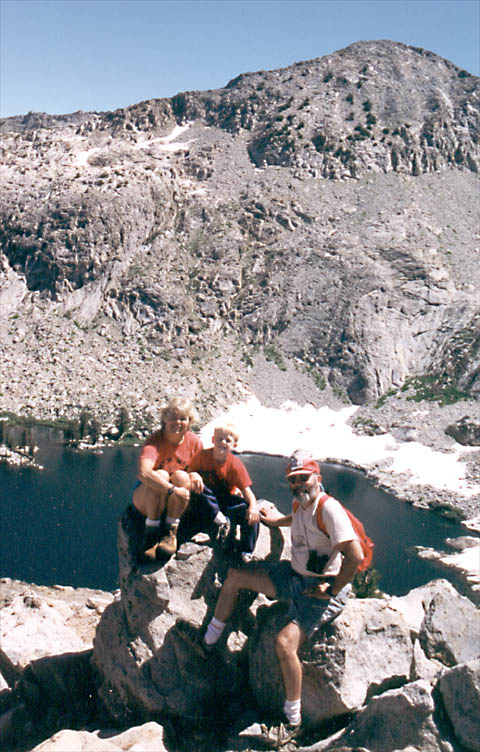
The general rule about camping in the wilderness is that campsites and fire rings must be 100 feet from any lake or running stream. As a service project, the Forest Service has asked us, as a group, to go around the lakes and identify the fire rings and camp sites that violate the rules, and return them to nature, tossing any fire-scorched rocks into the lake.
Panorama taken from the ridge near Gale Peak. Drag the mouse around in the image to look around.
Use various helper keys (Control. Option, Command, Shift, Alt) to zoom in and out.

